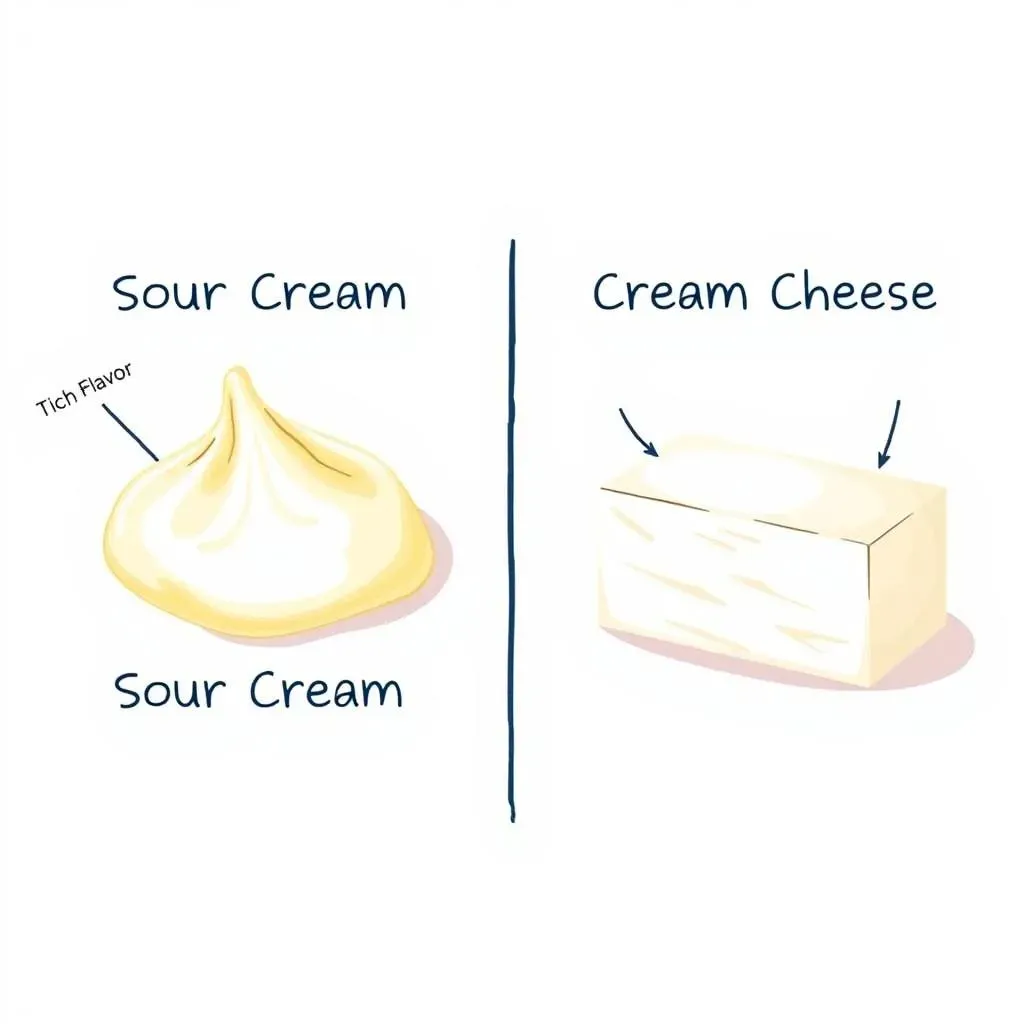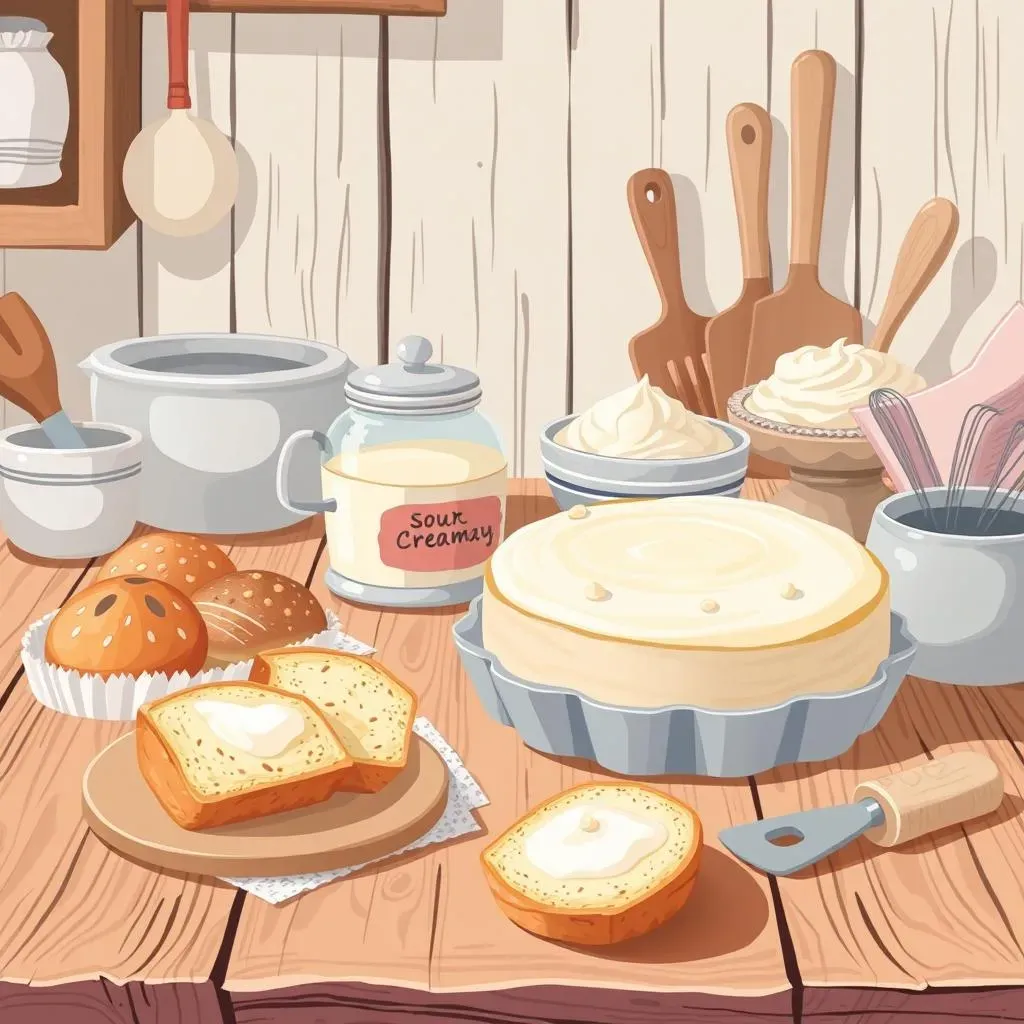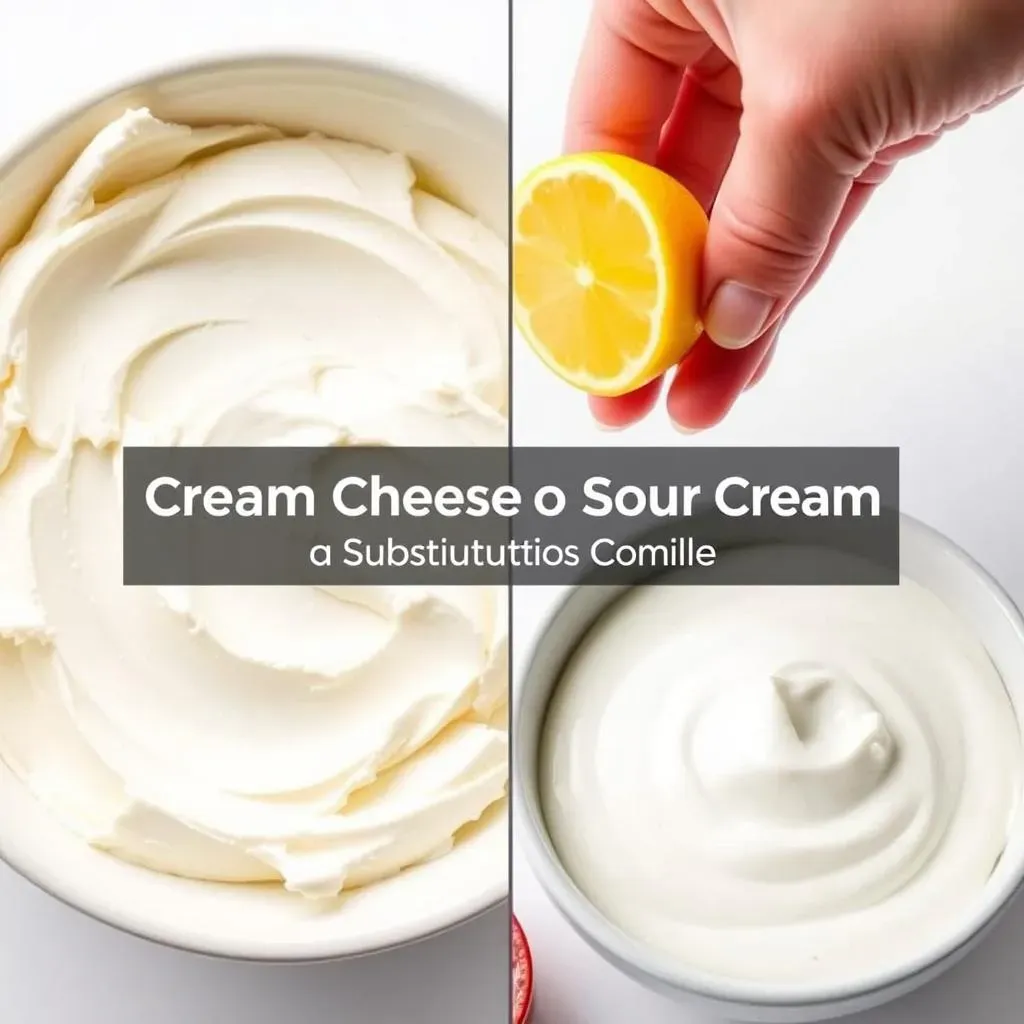Table of Contents
Ever found yourself mid-recipe, staring into the fridge, only to realize you're out of sour cream? It's a kitchen conundrum we've all faced. But what if I told you that creamy, tangy cream cheese might just be your secret weapon? That's right, you can often substitute sour cream with cream cheese, but it's not always a straight swap. This article is your guide to navigating this substitution, ensuring your dishes turn out as delicious as intended. We'll explore the key differences between these two dairy staples, discover when it's safe to swap them, and, most importantly, learn how to do it properly so you can rescue that cheesecake or perfect that dip without missing a beat. So, let's get cooking and uncover the secrets of this surprisingly simple substitution!
Cream Cheese vs. Sour Cream: Understanding the Differences

Cream Cheese vs. Sour Cream: Understanding the Differences
The Tangy Truth About Sour Cream
Let's start with sour cream, the tangy titan of the dairy aisle. It's made by fermenting regular cream with lactic acid bacteria, which is just a fancy way of saying some good bacteria make it taste, well, sour. This process also gives it that signature thick, yet pourable consistency. Think of it as the slightly rebellious cousin of regular cream – it’s got a bite, a zest, that makes it perfect for adding a little zing to your dishes. It's that dollop on your baked potato, the secret ingredient in your stroganoff, that makes everything taste just a little bit better.
Cream Cheese: Dense and Dreamy
Now, let's talk about cream cheese. This stuff is a different beast altogether. It's made by coagulating milk and cream, separating the whey, and then processing the curds. The result? A dense, spreadable, and wonderfully rich product. It's that smooth base for your cheesecake, the essential component of your bagel topping, and the creamy secret in many dips and frostings. Cream cheese is less about tang and more about that luxurious, melt-in-your-mouth texture. It's the velvet glove of the dairy world, adding a touch of elegance and richness to everything it touches.
Feature | Sour Cream | Cream Cheese |
|---|---|---|
Primary Flavor | Tangy, Sour | Mild, Rich |
Consistency | Thick, Pourable | Dense, Spreadable |
Fat Content | Lower | Higher |
Production | Fermented Cream | Coagulated Milk and Cream |
The Key Differences
So, while both are dairy products, their differences are pretty significant. Sour cream brings a bright, acidic tang and a lighter body, while cream cheese offers a rich, mild flavor and a much denser texture. This difference in their makeup means they don't always behave the same way in recipes. The fat content is also worth noting, cream cheese packs a higher fat content, making it richer and more decadent, while sour cream is lighter. Understanding these differences is key to knowing when you can substitute one for the other. Think of it like this, they’re both in the same dairy family, but they have their own unique personalities.
When to Substitute Cream Cheese for Sour Cream

When to Substitute Cream Cheese for Sour Cream
Okay, so you know the difference between these two. Now, when can you actually swap them? It's not a free-for-all, that's for sure. Think of it like this: if the recipe is heavily reliant on that sour tang, cream cheese might not be the best stand-in. However, in situations where you're looking for richness and a creamy texture, cream cheese can absolutely save the day. For instance, in dips or sauces where the primary goal is a smooth, thick consistency, cream cheese can do the job beautifully. Also, in baked goods, especially where you're not depending on the sour cream for leavening, it can work wonders. It adds a touch of richness and moisture that can be quite delicious.
But, hold your horses! There are times when using cream cheese as a substitute for sour cream might not be ideal. If you're making something like a classic sour cream cake, where that tang is really the star, you might find that cream cheese just doesn't cut it. The result will be less tangy and more dense, which might not be what you’re going for. Another instance where you should proceed with caution is when you're using sour cream in a recipe that requires its lighter consistency, such as a salad dressing or a thinner sauce. Cream cheese is much denser, so it won't give you the same pourable result. It's about knowing the nuances of your recipe and what role the sour cream is playing.
Recipe Type | Cream Cheese as a Substitute | Notes |
|---|---|---|
Dips | Often a good choice | Adds richness and thickness. |
Sauces (thick) | Suitable | For creamy, not tangy sauces. |
Baked Goods | Potentially good | Best when tang is not key. |
Dressings | Not recommended | Too thick for most dressings. |
Sour Cream Cakes | Not recommended | Tang is essential. |
How to Substitute Cream Cheese for Sour Cream in Recipes

How to Substitute Cream Cheese for Sour Cream in Recipes
The 1:1 Swap: When It Works
Alright, so you're ready to roll up your sleeves and make the swap. The simplest way to substitute sour cream with cream cheese is a 1:1 ratio. That means if your recipe calls for one cup of sour cream, you use one cup of cream cheese. This works well when you're aiming for a similar thickness and don't need that signature sour cream tang. Think dips, creamy pasta sauces, or even baked goods where the tang isn't the star of the show. It's all about context, if the recipe is forgiving and the tang isn't crucial, you're usually good to go with a straight swap.
But, and there's always a but, you need to consider the consistency. Cream cheese is denser than sour cream, so sometimes you'll need to soften it up a bit. If it's straight from the fridge, it can be hard to mix, especially if you are aiming for smooth texture. You can either leave it out at room temperature for a bit or give it a quick zap in the microwave. Just remember to stir it well to get it nice and smooth before you add it to your recipe. It’s all about making sure it plays nice with the other ingredients, you don't want chunks of cream cheese in your dip.
Adjusting for Tang and Texture
Now, let's say you need a bit of that sour cream tang. You can't just swap cream cheese and expect the same result. The solution? A little bit of lemon juice or white vinegar can do the trick. A teaspoon of either to a cup of cream cheese can give it a slight tang that's closer to sour cream. Start with a small amount and taste as you go, you can always add more, but you can't take it out. Also, if you're working with a recipe where the liquid content is important, you might want to thin the cream cheese out a bit. You can use a splash of milk or even a bit of the liquid from your recipe to get it to a more pourable consistency. It's all about playing around and getting the texture and taste just right.
Another thing to think about is the fat content. Cream cheese is generally richer than sour cream, so keep that in mind. If you're substituting it in a recipe where you want to cut down on the fat, this might not be the best option. However, if you are looking for that luxurious mouthfeel, then cream cheese is your best friend. Ultimately, it's all about knowing your recipe and what you want to achieve. Don't be afraid to experiment, a little tweak here and there can make all the difference. It's all part of learning how to be a confident cook.
Adjustment | How to Do It | Why It Works |
|---|---|---|
Add Tang | Mix in lemon juice or white vinegar | Mimics sour cream's acidity. |
Thin Texture | Add milk or recipe liquid | Makes it more pourable. |
Soften Cream Cheese | Leave at room temp or microwave briefly. | Makes it easier to mix. |
Adjusting Your Recipe: The Cream Cheese Substitute Guide

Adjusting Your Recipe: The Cream Cheese Substitute Guide
Taste Testing and Tweaking
Okay, so you've made the swap, you've softened the cream cheese, maybe even added a touch of lemon juice. Now what? Well, it's time to taste test, my friend. This is where you put on your chef's hat and really get a feel for how the substitution worked out. Before you go all in, take a small sample and see what you think. Does it need more tang? Maybe a bit more liquid? Don't be afraid to tweak it, a little bit of adjustment can make a big difference. Remember, cooking is all about experimenting and finding what works for you. It's not always about following a recipe to the letter, it's about making it your own and getting the flavors just right for your taste buds.
Think of it like tuning a musical instrument. You wouldn't expect a guitar to sound perfect without a little bit of adjustment, right? Same goes for cooking. You might need to add a pinch of salt here, a dash of pepper there, or maybe a bit more lemon juice to get the perfect balance of flavors. It's all part of the process and it's what makes cooking so much fun. And hey, if it doesn't turn out quite as planned, it's just a learning experience. The next time you substitute sour cream with cream cheese, you'll be even more prepared.
When Things Go Wrong (and How to Fix Them)
Let's be real, sometimes things go a little sideways in the kitchen. Maybe your cream cheese substitute is too thick, or maybe it just doesn't have that zing you were hoping for. Don't panic, it happens to the best of us. If your mixture is too thick, a little bit of milk or water can help to thin it out. Add a tablespoon at a time until you reach your desired consistency. If the tang is missing, a little more lemon juice or white vinegar can work wonders. Remember, it's all about small adjustments. Also, if your recipe calls for cooking the cream cheese, you might want to add it at the end, as sometimes it can break down and become grainy if it's heated for too long.
The key is to not give up, even if things don't go perfectly the first time. Think of each cooking mishap as a mini-experiment. You'll learn something new, and the next time you face a similar situation, you'll be better equipped to handle it. It's all part of becoming a confident cook. After all, even the most seasoned chefs have their share of kitchen mishaps, it’s how you learn and grow in the kitchen that truly matters. So, don't be afraid to experiment, make mistakes, and learn from them. It's all part of the fun.
Problem | Solution | Why it Works |
|---|---|---|
Too Thick | Add milk or water (1 tbsp at a time) | Thins out the mixture. |
Not Tangy Enough | Add lemon juice or white vinegar (1/2 tsp at a time) | Adds acidity. |
Grainy Texture | Add cream cheese at the end of cooking | Prevents breaking down. |
Wrapping Up: The Cream Cheese Substitute Success
So, there you have it! Substituting sour cream with cream cheese isn't as scary as it might seem. While they aren't identical, understanding their differences and how to adjust your recipes can open up a world of possibilities in the kitchen. Whether you're baking a cake, whipping up a dip, or simply looking for a tangy twist, cream cheese can be a surprisingly effective stand-in. Remember to consider the moisture content and adjust accordingly, and don't be afraid to experiment! With a little know-how, you can confidently tackle any recipe, even when sour cream takes a surprise vacation from your fridge.